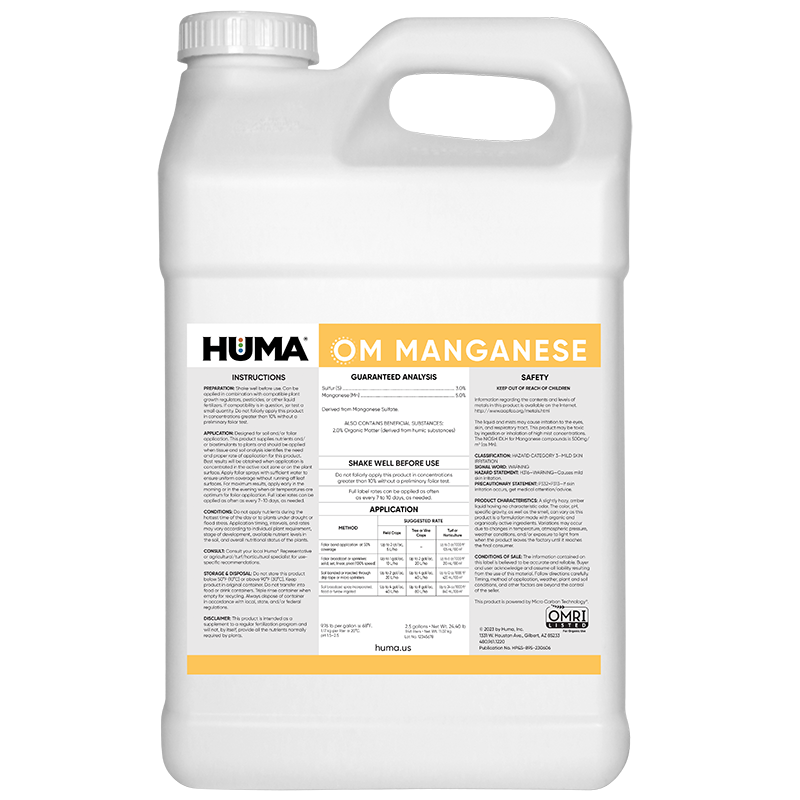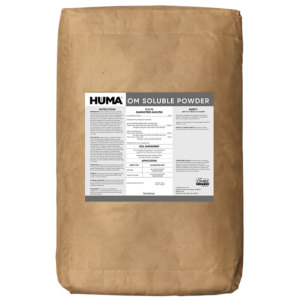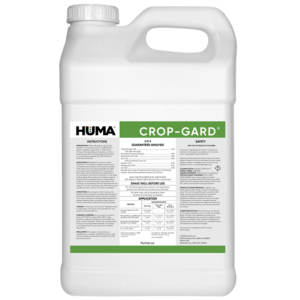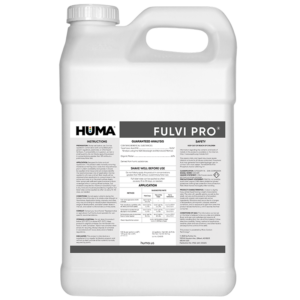OM MANGANESE
Benefits of Use:
- Effectively treats manganese deficiency symptoms
- An enzyme activator that aids in chlorophyll synthesis
- Closely associated with the micronutrients copper and zinc
- Activates the lipid enzymes
- Essential for assimilation of carbon dioxide in photosynthesis
- Functions in the formation of riboflavin, ascorbic acid, and carotene
- Improves formation of lateral roots
- Provides quick crop response and can be applied just prior to actual crop need
- Can be applied foliarly (according to label directions) without risk of phytotoxicity
- Can be effectively tank-mixed with other organic crop inputs
- Resists tie-up in the soil and remains available through the plant root system
Deficiency Symptoms-When to Apply:
- Chlorosis and/or mottling due to manganese deficiency
- Plants may be pale green to yellow-red in color between green veins on soybeans, tomatoes, and beets
- Tips of small grains turn gray to white (gray speck in oats)
- In neutral to alkaline soils high in calcium and in organic soils where manganese is
less available
FAQs
Related Products
Related Case Studies
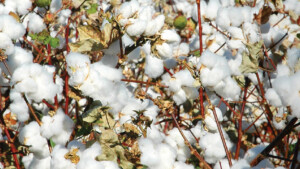
Super Potassium on Cotton
Background: Farmers who try to supply K2O needs on the farm don’t have too many options to get K into the plant, especially in deficient soils. A typical application is KCl which contains an excess amount of Chloride which may not be beneficial to the plant and soil microbes. Huma’s Micro Carbon Technology® based Super

X-Tend® B With Micro Carbon Technology® Improves Barley Yield and Net Income: Year 3
Background Enhanced Efficiency Fertilizer (EEF) additives can improve crop production. Humates have been shown to improve crop yield. The Huma® EEF additive X-Tend® B is a concentrated Micro Carbon Technology® product derived from humates with high levels of organic acids and nutrients that is formulated to be blended in liquid fertilizers or to be impregnated

One-Hour Tissue Absorption Study
Background When applying foliar sprays, it’s highly beneficial for crop nutrients to quickly enter the plant tissue. Farmers often have a short application window and need to make sure the nutrients get into the plant prior to rain Objective Observe how fast a foliar application of Huma® Super Potassium® (0-0-40), powered by Micro Carbon Technology®,
Related Blog Posts

Discover Three Products to Prep Your Soil for Spring Planting
As I begin to write, I’m reminded of an excerpt from Ode to the West Wind — “If winter comes, can spring be far behind?” Well, spring is certainly not far behind, especially for those of us working in the agriculture sector. Winter can be a tricky time for growers, as many of them face

NITROGEN vs. CARBON – NEW AND IMPORTANT INFORMATION
For decades the conventional thinking has been that applications of synthetic nitrogen fertilizers help enhance soil carbon levels by stimulating soil microbes to feed on organic matter from crop residues. New research indicates that, in fact, the opposite may be true.A group of scientists at University of Illinois says that research from the Morrow Plots,

Mighty Micronutrients – Q&A with CMO Fred Nichols
Fred Nichols, Chief Sales and Marketing Officer at Huma®, shared his perspective in a recent article on micronutrient technology, published in CropLife. In the article, Fred discusses how advancements in micronutrient formulations are meeting increased demand, improving nutrient availability, and enhancing crop performance. Below are the key topics along with Fred’s insights.

